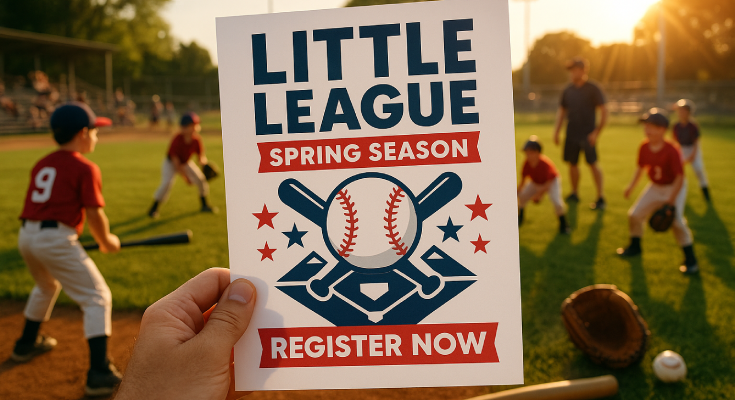Little league baseball flyers serve as the crucial first impression for families considering youth baseball participation, directly impacting registration success and community engagement. Little league baseball flyers are specialized marketing materials designed to attract families with children ages 4-12 to youth baseball programs. Effective little league flyers balance kid-friendly visual appeal with parent-focused information, including age divisions (T-ball, coach-pitch, kid-pitch), safety protocols, volunteer opportunities, and registration details. If you’re ready to build your own, our step-by-step guide on how to create a flyer will help you craft one that converts interest into sign-ups.
The best little league baseball flyer designs incorporate Little League International branding guidelines while addressing parent decision-maker concerns about scheduling, costs, and community involvement for maximum registration conversion. Successful campaigns show that dual-audience messaging can boost registration by up to 35%, while community-focused visuals lead to 40% higher parent engagement than generic layouts. You’ll also find plenty of adaptable flyer templates that work well for youth sports and community-focused events, making it easier to create a flyer that feels relevant and inviting to local families.
This comprehensive guide covers age-appropriate design strategies that appeal to both children and parents, Little League International branding compliance requirements, and community integration frameworks for local relevance and maximum participation potential.
What Age-appropriate Design Elements Make Little League Baseball Flyers Appeal To 4-12 Year Olds?
Age-appropriate design elements for little league baseball flyers include bright primary colors (red, blue, yellow) that naturally appeal to children, combined with clear visual hierarchy for parent information scanning. T-ball flyers (ages 4-6) should emphasize fun with cartoon illustrations and minimal text, coach-pitch designs (ages 7-8) balance playful graphics with basic baseball elements, while kid-pitch flyers (ages 9-12) incorporate more sophisticated action photography and achievement-focused messaging to match developmental stages.
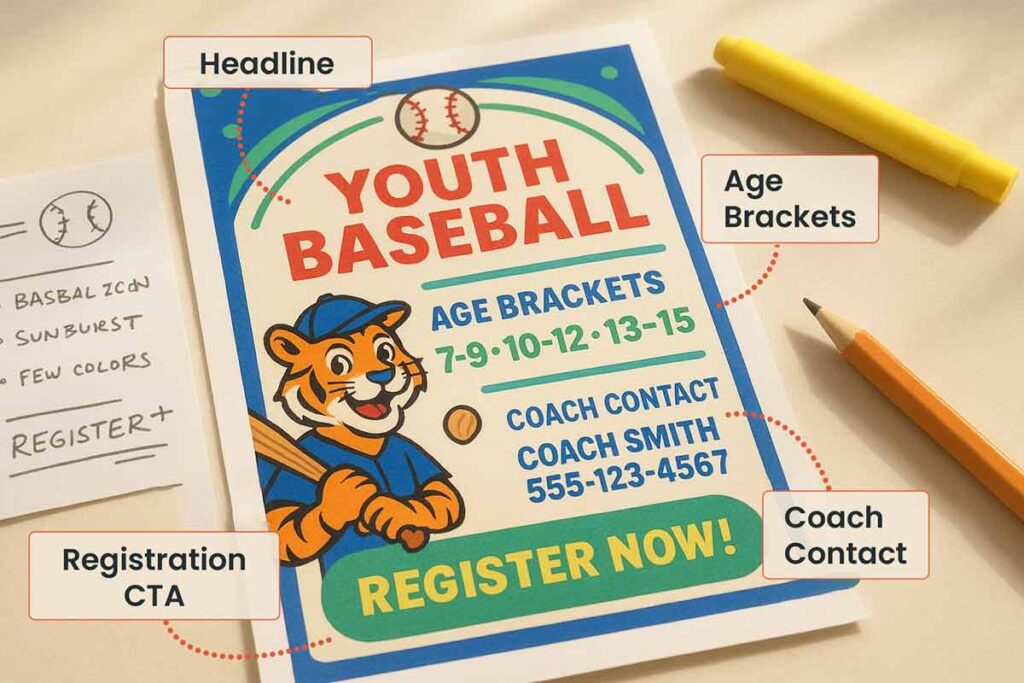
Visual Elements by Age Division
T-Ball Division Design Strategy (Ages 4-6) requires bright primary color schemes with high contrast and simple cartoon illustrations. “Children have positive reactions to bright colors and that these emotional reactions become increasingly positive with age1“. Minimal text with large, clear fonts ensures parent readability while maintaining visual excitement. Fun, rounded design elements convey safety and play-focused messaging.
requires bright primary color schemes with high contrast and simple cartoon illustrations. Research demonstrates that children have positive reactions to bright colors and that these emotional reactions become increasingly positive with age². Minimal text with large, clear fonts ensures parent readability while maintaining visual excitement. Fun, rounded design elements convey safety and play-focused messaging.
Coach-Pitch Division Approach (Ages 7-8) balances fun graphics with basic baseball imagery, introducing team concept visuals and group activities. Readable fonts with information hierarchy support parent scanning while action elements showcase skill development progression.
Kid-Pitch Division Sophistication (Ages 9-12) incorporates more advanced photography and action shots with achievement and competitive elements appropriately balanced. Leadership and teamwork visual messaging prepares players for higher-level baseball pathway communication while maintaining age-appropriate excitement.
Color Psychology and Typography Integration
Primary Color Application for Maximum Appeal utilizes red, blue, and yellow combinations that research shows create strongest visual attraction for children ages 4-12. These colors maintain high visibility for outdoor posting while appealing to young athletes’ energy levels.
Team Color Integration Strategies blend official Little League colors with local team identity, creating community connection while maintaining brand consistency.
Font Selection for Dual-Audience Readability employs sans-serif fonts like Arial or Calibri in 12-14 point sizes for body text and 18+ points for headers, enabling quick parent scanning while remaining engaging for children.
14-point font size is considered easier and quicker to read, as well as being more attractive and desired⁵. Federal accessibility guidelines recommend using at least an effective size of 16px for body text to ensure comfortable reading.2
Visual Hierarchy Techniques for Information Processing structure critical parent information (registration dates, costs, schedules) prominently while maintaining visual excitement through strategic color placement and imagery that draws children’s attention without overwhelming essential details.
- Dynamic Green Baseball Fundraiser Dinner Event Flyer
- Dynamic Red Baseball Tryouts for Young Athletes Flyer
- Dynamic Green Baseball and Softball Camp Registration Flyer
- Pattens Blue and Oregon Youth Softball Flyer
Imagery Guidelines and Representation Standards
Diverse Player Representation Requirements showcase children from various backgrounds participating actively in baseball activities, reflecting community demographics and promoting inclusive participation.
Safety Equipment Prominence in Visual Design features properly fitted helmets, appropriate gloves, and age-specific equipment without creating fear-based messaging. Safety gear appears as natural part of the baseball experience rather than cautionary requirement.
Age-Appropriate Action Photography Standards capture developmental stage activities T-ball focuses on learning fundamentals, coach-pitch shows basic skill development, kid-pitch emphasizes teamwork and achievement.
Community Integration Through Local Elements incorporates recognizable local landmarks, school colors, or community features that create immediate relevance for target families. Local business sponsorship acknowledgment and familiar geographic references enhance community connection and registration appeal.
- Community Baseball Fundraiser Event Flyer
- Community Baseball Tournament Event Flyer
- Baseball Try Outs Event Flyer
How Do I Balance Parent Decision-maker Needs With Kid-friendly Little League Baseball Flyer Design?
Balancing parent decision-maker needs with kid-friendly appeal requires strategic visual hierarchy using 60% parent information focus and 40% child appeal elements. Effective little league flyer designs place critical decision factors like cost, time commitment, and safety protocols prominently while maintaining visual excitement through colors and imagery. Addressing cost effectively—without sacrificing visual appeal—can make a big difference in how your flyer is received; that’s where baseball flyer budget solutions can help. Key parent concerns include transparent cost communication, volunteer expectations, safety certifications, and scheduling flexibility, all presented with clear typography and scannable formatting for busy family decision-making processes.
Balancing parent decision-maker needs with kid-friendly appeal requires strategic visual hierarchy using 60% parent information focus and 40% child appeal elements. Effective little league flyer designs place critical decision factors like cost, time commitment, and safety protocols prominently while maintaining visual excitement through colors and imagery. Key parent concerns include transparent cost communication, volunteer expectations, safety certifications, and scheduling flexibility, all presented with clear typography and scannable formatting for busy family decision-making processes.
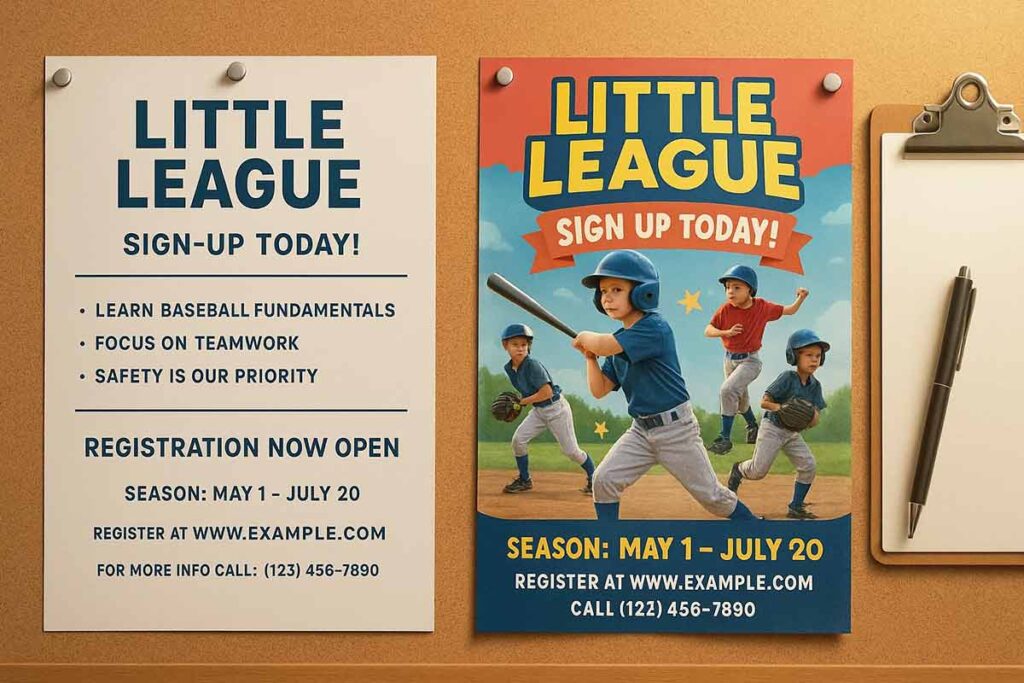
Dual-Audience Design Strategy
Create visual zones that serve both audiences simultaneously without compromising either group’s needs. Position essential parent information in the upper two-thirds of the flyer using clear headers like “Registration Details,” “Season Schedule,” and “Volunteer Opportunities.” Reserve the bottom third for child-focused elements including team mascots, action photography, and achievement imagery that builds excitement.
Use contrasting typography sizes to establish information hierarchy – 18-point headers for parent scanning, 14-point body text for detailed information, and colorful accent text for child appeal elements. “Effective youth sports marketing requires emphasis on fun, camaraderie, and sense of achievement that kids experience while participating while simultaneously providing comprehensive information for parent decision-makers.3” Implement color psychology by using professional blues and greens for parent information sections while incorporating energetic reds and oranges for kid-friendly elements. This dual-zone approach ensures parents can quickly locate decision-critical information while children remain engaged with visually appealing design elements.
Critical Parent Decision Factors
Address time commitment transparency by clearly stating practice frequency, game scheduling, and total season duration in prominent header sections. Include specific cost breakdowns covering registration fees, uniform expenses, and optional equipment purchases to prevent surprise financial obligations. Safety messaging should emphasize background-checked coaches, age-appropriate equipment standards, and comprehensive insurance coverage without creating anxiety.
Volunteer opportunity communication requires careful balance – present involvement as community building rather than mandatory obligation. Use positive language like “Join Our Team Parent Network” instead of “Volunteer Requirements Needed.” Include flexible commitment options ranging from one-time event assistance to seasonal coaching positions, emphasizing that training and support are provided for all roles.
Design Layout Optimization
Structure layouts using F-pattern reading flow that accommodates parent scanning behavior while incorporating visual interest for children. Place critical information along the left margin and top sections where parent eyes naturally focus during quick evaluation. Integrate child appeal elements strategically within parent information zones rather than segregating them completely.
Implement clear call-to-action hierarchy with primary registration information prominently featured and secondary details easily accessible. Use visual breaks including white space, borders, and background colors to separate information categories without overwhelming busy parents. Include multiple contact methods and registration deadlines in easy-to-locate positions. Balance information density by using bullet points for complex details while maintaining visual appeal through strategic use of graphics and team photography that supports rather than distracts from essential parent decision-making information.
What Little League International Branding Requirements Must Little League Baseball Flyers Follow?
Little League International branding compliance requires proper official logo usage, approved color specifications, required disclaimers including charter information, and adherence to trademark guidelines. Flyers must display Little League International registration language, local league charter numbers, insurance coverage statements, and age verification requirements. Compliance involves using authorized logo placement and sizing, avoiding unauthorized modifications, and maintaining current brand guideline documentation for legal protection and organizational credibility.
Official Logo and Trademark Requirements
Authorized logo placement specifications require the official Little League International logo appear prominently on all promotional materials with minimum size requirements of one inch in height. Color specification compliance mandates using approved red, white, and blue color combinations without alterations to hue or saturation. Prohibited modifications include stretching, rotating, or adding effects to the official logo. Commercial usage requires written permission for enhanced designs beyond basic promotional materials. Brand consistency becomes even more important during larger events such as tournaments, where visibility and audience reach are higher. Enhancing baseball tournament promotions with eye-catching flyers explores how visual strategy supports recognition without compromising trademark standards. Quality control measures ensure consistent organizational representation through high-resolution logo files and proper contrast ratios against background colors.
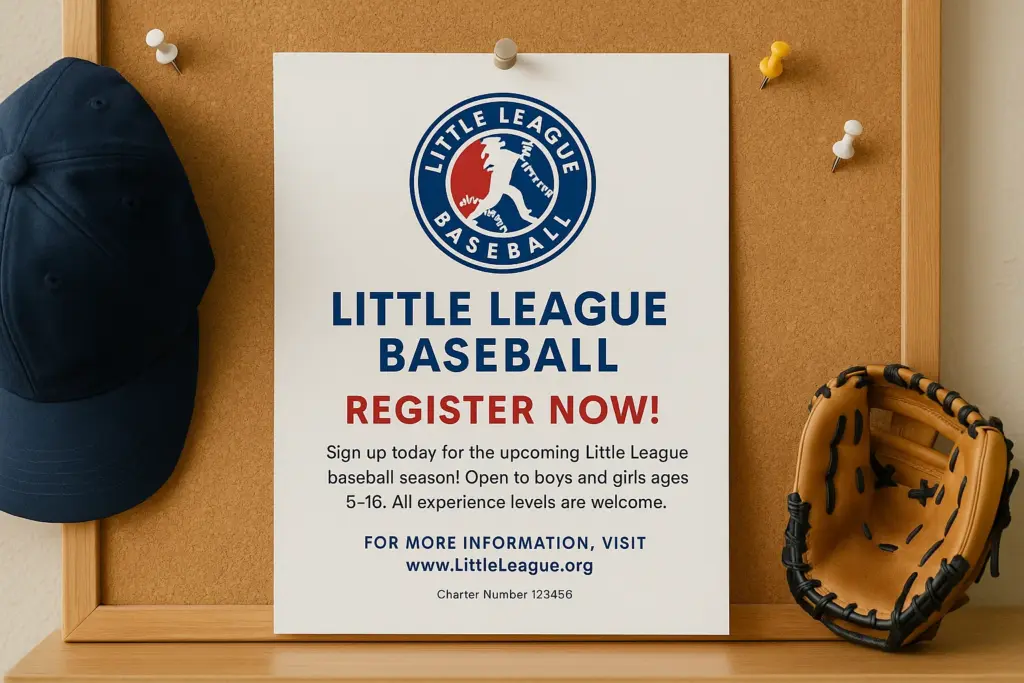
Required Disclaimers and Legal Language
Little League International registration language must include the statement “This league is chartered under Little League Baseball, Incorporated” prominently displayed on all materials. Local league charter numbers require clear visibility, typically positioned near the official logo or contact information. Insurance coverage statements must reference Little League International’s comprehensive liability coverage and emergency medical procedures. Age verification requirements include eligibility documentation language stating “Birth certificate verification required for registration” with specific cutoff date information. These legal elements protect both local leagues and participants while maintaining organizational standards and insurance compliance requirements.
Brand Consistency Standards
Official typography standards require using approved fonts including Arial, Helvetica, or Times New Roman for body text with consistent sizing hierarchies. Color scheme adherence involves using official Little League colors (red PMS 186, blue PMS 287) for headers and accent elements. Approved tagline integration includes “Character, Courage, Loyalty” when space permits, positioned according to brand guidelines. Sponsorship acknowledgment guidelines require sponsor logos to be smaller than Little League branding and positioned below organizational information. Quality control measures include maintaining current brand guideline documentation and regular compliance reviews to protect trademark integrity and organizational reputation.
Compliance Implementation Process
District administrator approval workflow requires submitting flyer designs for review before printing, typically 10-14 days in advance of distribution. Regular brand guideline updates monitoring involves checking Little League International’s website quarterly for revised standards and implementation requirements. Documentation maintenance includes keeping approval records, correspondence files, and updated brand guideline versions for legal protection during audits. Template approval systems establish pre-approved design formats that local leagues can customize within compliance parameters, streamlining the approval process while maintaining consistency. This systematic approach ensures all promotional materials meet organizational standards and protect against trademark violations.
How Can I Incorporate Safety Messaging In Youth Baseball Flyers Without Creating Fear?
Incorporating safety messaging in youth baseball flyers requires positive framing emphasizing “fun and safe environment” rather than fear-based language.
The CDC’s HEADS UP training provides essential information to help coaches spot signs and symptoms of possible concussions and steps to take if one occurs, demonstrating how safety education can be presented professionally rather than alarmingly. 4
When framed as part of a well-rounded player experience, safety becomes a confidence booster for parents rather than a point of concern. It often goes hand in hand with topics like skill-building, teen development, and preparation for the next level, which are central to baseball youth programs flyers. Effective approaches include highlighting professional coaching certifications, equipment safety standards, age-appropriate skill development, and comprehensive insurance coverage. Visual safety indicators include proper equipment imagery, safe playing environment photography, and coach-to-player ratio illustrations, all presented as program benefits rather than necessary precautions for optimal parent confidence building.
Positive Safety Communication Framework
Professional environment emphasis creates confidence through certified coaching staff and trained volunteers. Equipment safety standards showcase age-appropriate gear and facility safety measures. Skill development focus highlights progressive learning and injury prevention through proper instruction.
Through friendly competition, teamwork, and physical activity, kids have the opportunity to learn new skills, develop self-confidence, build character, emphasizing the developmental benefits of structured sports programs.5
Community support demonstrates emergency preparedness and comprehensive care protocols. Frame safety measures as competitive advantages: “Our certified coaches ensure proper technique development” rather than “preventing injuries.” Include background check transparency, training certification displays, and insurance coverage communication. Emphasize qualified leadership and organizational standards that attract quality-conscious parents seeking structured youth sports experiences.
Parent Reassurance Integration
Background check transparency demonstrates coach and volunteer screening processes without suggesting danger. Training certification displays include first aid, CPR, and safety protocol education as professional qualifications. Insurance coverage communication emphasizes comprehensive protection and emergency procedures as program features. Emergency contact systems highlight clear protocols and parent notification procedures as organizational excellence indicators. Present these elements through benefit-focused language emphasizing program quality rather than risk mitigation. Include testimonials from satisfied parents about peace of mind and positive experiences. Demonstrate proactive care through systematic approaches that build trust.
Visual Safety Implementation
Equipment photography shows proper safety gear usage in action shots naturally integrated into gameplay imagery. Environment documentation features safe field conditions and facility features as attractive program elements. Supervision illustration displays appropriate coach-to-player ratios and oversight as quality indicators rather than safety necessities. Age-appropriate activity visuals demonstrate developmental stage matching and skill progression. Use bright, positive imagery showing engaged players wearing proper equipment during fun activities. Include facility shots highlighting well-maintained fields, updated equipment, and organized environments. Visual elements should communicate professionalism and care without emphasizing potential hazards or dangers.
Fear Avoidance Strategies
Benefit-focused language emphasizes positive outcomes and developmental advantages rather than risk prevention. Community emphasis highlights supportive environment and shared responsibility among families. Professional credibility showcases qualified leadership and organizational standards as attractive features. Success communication focuses on achievement and positive player experiences. Replace cautionary language with opportunity language: “comprehensive training” instead of “injury prevention,” “professional supervision” instead of “safety monitoring.” Include progress tracking, skill celebration, and team achievement messaging. Present safety protocols as evidence of program quality and professional standards that enhance the overall experience for young athletes and their families.
What Volunteer Recruitment Strategies Work Best In Little League Baseball Flyer Layouts?
Effective volunteer recruitment in little league flyers involves presenting essential roles as community building opportunities rather than obligations. Successful strategies include emphasizing “no experience necessary” messaging, flexible time commitment options, skill-based volunteer matching, and family involvement benefits. Visual integration includes parent participation photography, volunteer recognition elements, and community impact messaging that demonstrates the social value and personal satisfaction of Little League involvement while connecting families to available volunteer opportunities.
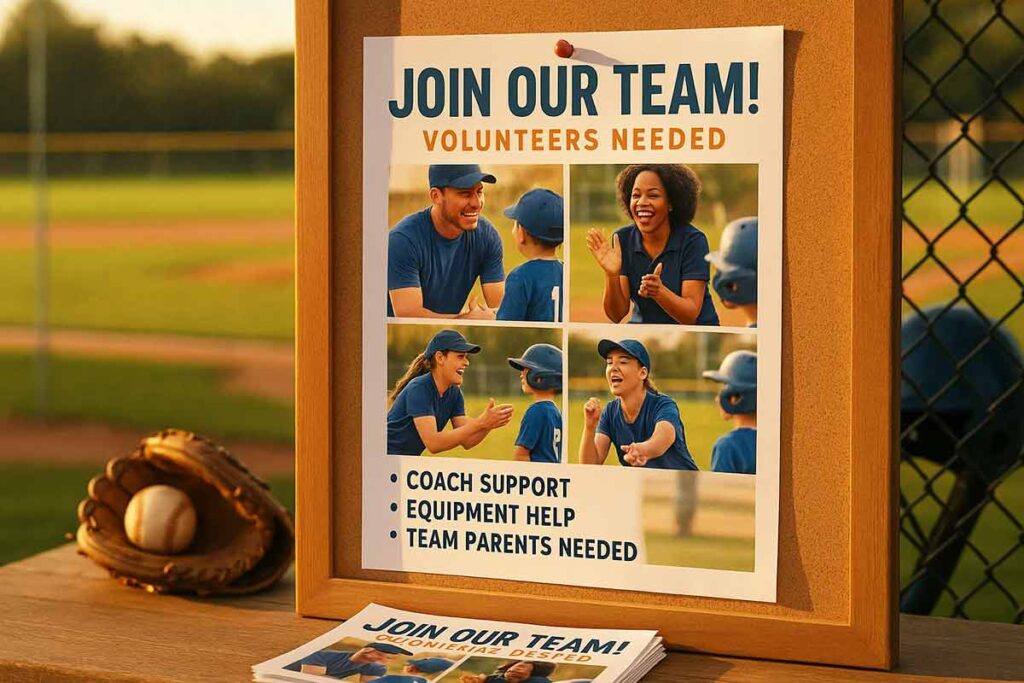
Essential Volunteer Role Communication
Present volunteer positions as meaningful community contributions with clear role descriptions. Coaching positions include head coach, assistant coach, and specialized instruction roles that shape young athletes. Team management encompasses team parent coordination, scorekeeper duties, and communication facilitation between families. League operations require concession management, field maintenance, and fundraising coordination that keeps programs affordable. Special events need volunteers for opening day ceremonies, tournament support, and awards celebrations that create lasting family memories.
Emphasize that each role directly impacts children’s baseball experience while building stronger neighborhood connections. Clear position descriptions prevent confusion and help parents identify suitable volunteer opportunities matching their skills and availability. For outreach, a baseball tournament flyers guide can highlight these roles, ensuring families and community members see how their contributions strengthen both the event and the league’s success.
Volunteer Appeal Strategy Development
Frame volunteering through community building messaging that highlights social connections and neighborhood involvement benefits. Offer flexible commitment options including seasonal participation, event-based involvement, and ongoing leadership roles that accommodate varying family schedules. Present volunteer service as personal skill development and leadership opportunities that provide growth through meaningful community service.
Family integration messaging demonstrates multi-generational involvement possibilities and shared experiences that create stronger family bonds. Provides comprehensive community sports involvement strategies. Position volunteering as mutual benefit where families gain as much as they contribute through lasting friendships and community connections.
Barrier Reduction Implementation
Address common volunteer hesitations through “no prior knowledge needed” messaging and comprehensive training provision. Emphasize time flexibility with multiple involvement levels and scheduling accommodation for working parents. Implement support systems including mentorship programs and gradual responsibility introduction that ease new volunteers into roles comfortably.
Recognition programs showcase volunteer appreciation and community acknowledgment that validates contributions. Create clear pathways for different commitment levels, from one-time event assistance to season-long positions, ensuring every family finds suitable involvement opportunities that fit their circumstances and interests.
Visual Integration Strategies
Include participation photography showing parents actively engaged in various volunteer activities that normalize involvement and demonstrate community atmosphere. Feature community impact visuals with before/after facility improvements and program growth documentation that shows volunteer contributions create tangible results.
Social proof elements include volunteer testimonials and satisfaction communication that build confidence in the volunteer experience. Family benefit imagery shows multi-generational involvement and relationship building that extends beyond baseball season. Offers volunteer-focused design options that effectively communicate community engagement opportunities while maintaining kid-friendly visual appeal.
How Do I Design Little League Baseball Flyers For Different Age Divisions?
Designing little league flyers for different age divisions requires understanding developmental stages and appropriate messaging. T-ball (ages 4-6) emphasizes fun learning with no scorekeeping, coach-pitch (ages 7-8) introduces teamwork and skill development, while kid-pitch (ages 9-12) focuses on competitive play and advanced skill preparation. Each division needs distinct visual approaches, parent messaging, and skill development communication that reflects age-appropriate expectations and developmental milestones for optimal program fit and family satisfaction.
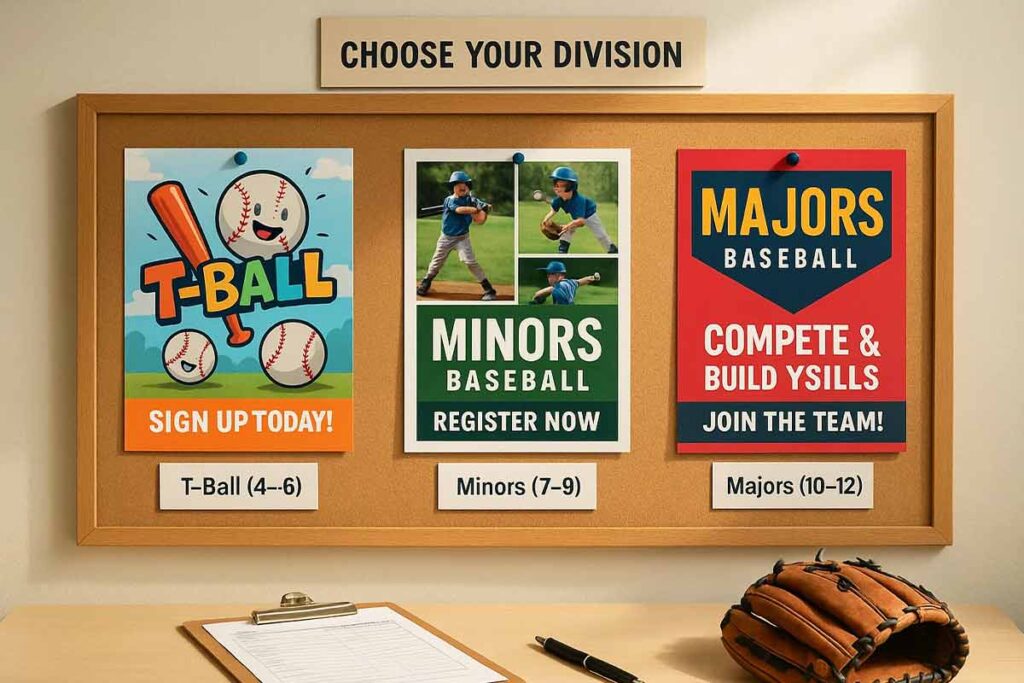
T-Ball Division Design and Messaging
T-ball flyers prioritize learning over competition with bright primary colors and cartoon-style graphics that appeal to young children. Focus messaging on “first baseball experience” with emphasis on fun activities, skill introduction through play, and zero-pressure environment. Parent communication should highlight the developmental benefits including social interaction, basic motor skills, and following simple instructions. Visual elements include oversized baseballs, smiling children, and T-ball specific equipment imagery.
Safety messaging emphasizes age-appropriate equipment modifications, shorter game times, and positive coaching approaches. Include volunteer opportunities that welcome parents new to baseball, emphasizing that no experience is necessary. Highlight the inclusive nature where every child participates equally regardless of skill level, addressing parent concerns about competitiveness at this developmental stage.
Coach-Pitch Division Development
Coach-pitch division flyers balance playful elements with basic baseball imagery, introducing team concepts while maintaining developmental focus. Visual design incorporates more structured baseball elements like diamond layouts and team formations while retaining child-friendly colors and approachable graphics. Messaging shifts toward skill progression, basic teamwork, and gentle introduction to game rules.
Parent communication addresses increased practice commitment while emphasizing continued learning priority over winning. Highlight volunteer coaching opportunities that provide basic training, addressing parent concerns about teaching unfamiliar skills. Include information about modified rules that accommodate developing abilities, such as hitting off a tee when struggling with pitched balls, demonstrating program flexibility and child-centered approach.
Kid-Pitch Division Advancement
Kid-pitch flyers adopt more sophisticated design elements with action photography, competitive imagery, and advanced baseball graphics that appeal to older children. Visual hierarchy emphasizes achievement, skill mastery, and preparation for higher levels while maintaining Little League fun-focused messaging. Colors can include team-specific schemes alongside traditional Little League branding.
Parent messaging addresses increased time commitments, travel possibilities, and more structured practice schedules. Emphasize leadership development opportunities, peer mentoring, and preparation for middle school baseball programs. Include information about all-star team selection processes and tournament opportunities while maintaining inclusive participation policies. Address volunteer needs for specialized positions like scorekeeping and umpiring that require baseball knowledge.
Cross-Division Considerations
Successful multi-division flyers require clear progression pathways showing advancement opportunities between divisions. Include age cutoff dates, skill assessment information, and placement guidance helping parents choose appropriate levels. Visual consistency across divisions maintains league identity while allowing age-specific customization.
Address sibling accommodation with family scheduling coordination and multiple registration discounts. Equipment requirements should show progression from basic T-ball gear to regulation kid-pitch equipment, helping families plan purchases. Include league-wide policies covering photo consent, volunteer expectations, and safety protocols that apply across all divisions.
Provides comprehensive program promotion strategies, while offer ready-to-customize designs for immediate implementation.
What Community Integration Elements Make Little League Baseball Flyers Locally Relevant?
Community integration in little league flyers requires incorporating local landmarks, business partnerships, school district connections, and neighborhood-specific messaging for maximum relevance and participation. Effective strategies include featuring recognizable community locations, highlighting local business sponsorships, coordinating with school calendars, and representing diverse community demographics. Geographic relevance involves accessible field locations, transportation considerations, and integration with community events for enhanced local connection and registration appeal.
Local Connection Strategy Implementation
Geographic reference through community landmarks creates immediate recognition and trust. Feature familiar locations like city parks, local schools, or community centers where families gather. Business partnership integration showcases local sponsor recognition and demonstrates community business support. School district coordination aligns registration timing with academic calendars, preventing conflicts with other activities. Neighborhood messaging addresses area-specific demographics and cultural considerations, ensuring inclusive communication that reflects community diversity. Municipal recreation integration through parks department collaboration maximizes facility utilization and demonstrates official community support for youth baseball programs.
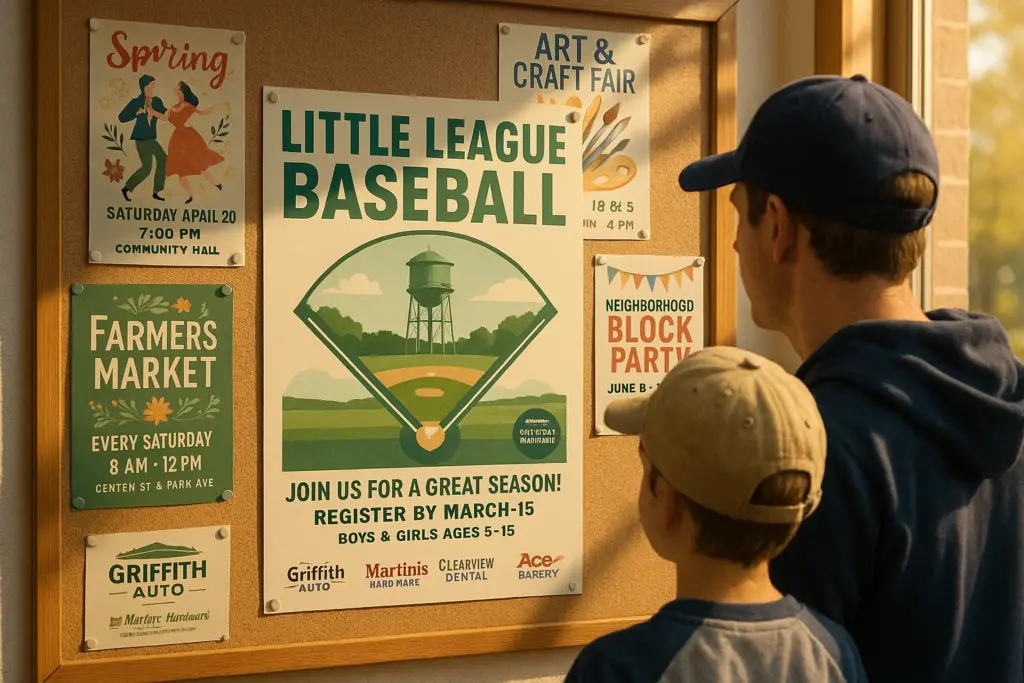
Cultural and Demographic Considerations
Inclusive representation reflects community diversity through imagery and messaging that represents all neighborhood families. Multi-language accommodation provides translation services and culturally appropriate communication for non-English speaking families. Cultural event integration coordinates with community celebrations and religious observances to avoid scheduling conflicts. Accessibility standards ensure ADA compliance and inclusive participation policies for children with special needs. Economic sensitivity addresses varying family financial situations through scholarship programs and flexible payment options. Visual representation includes diverse player imagery showing different ethnicities, abilities, and family structures that mirror actual community composition.
Partnership Development Opportunities
Municipal recreation integration establishes parks department collaboration and facility sharing agreements. Educational institution coordination creates school system partnerships and student engagement opportunities. Community organization alliance develops civic group collaboration and mutual support systems. Business sponsorship integrates local commerce participation and mutual promotional opportunities. Healthcare provider partnerships offer sports physicals and injury prevention education. Local media collaboration ensures community newspaper coverage and radio station promotional support. Restaurant partnerships provide team meal discounts and post-game celebration venues, strengthening community business relationships and family convenience.
Geographic Accessibility Communication
Field location information includes clear directions, parking availability, and accessibility features for families with mobility needs. Transportation details cover public transit access, carpool coordination, and mobility assistance programs. Facility features highlight amenities like restrooms, concession availability, and spectator seating arrangements. Event integration coordinates with community calendar to avoid conflicts with local festivals or school events. Safety communication emphasizes well-lit parking areas, secure facilities, and emergency access routes. Distance considerations address commute times from various neighborhoods and provide multiple practice location options when available for maximum family convenience and participation accessibility.
PEOPLE ALSO ASK: Essential Little League Flyer Questions
- What flyer size works best for little league baseball parent handouts?
Standard 8.5×11 letter size provides adequate space for essential information while fitting easily in backpacks and home filing systems, printing economically on standard equipment. - What colors make little league baseball flyers appealing to young children?
Bright primary colors (red, blue, yellow) combined with green create maximum appeal for children while maintaining high visibility and readability for parent information sections. - Should little league baseball flyers use portrait layout for better parent readability?
Portrait layout provides natural reading flow for parent information, accommodates standard printing formats, and allows better information hierarchy with headers and detailed sections. - What fonts help parents quickly scan little league baseball flyer information?
Sans-serif fonts like Arial or Calibri in 12-14 point size for body text and 18+ points for headers enable quick scanning with bold formatting for critical details. - How much text should little league baseball flyers include without overwhelming busy parents?
200-400 words maximum focusing on essential information: age divisions, registration dates, costs, practice schedules, and contact details using bullet points and clear headers. - What paper quality ensures little league baseball flyers survive outdoor posting?
80-100 GSM paper or cardstock provides durability against weather and handling while remaining cost-effective for bulk printing and community distribution requirements.
FAQs: Complete Implementation Guide
- What age divisions should little league baseball flyers clearly distinguish (T-ball vs kid-pitch)?
Little league baseball flyers should clearly separate T-ball (ages 4-6), coach-pitch (ages 7-8), and kid-pitch (ages 9-12) divisions with distinct sections or separate flyers. Each division requires different messaging: T-ball emphasizes fun and learning with no scorekeeping, coach-pitch introduces basic competition and teamwork, while kid-pitch focuses on skill development and preparation for higher levels. Clear age division communication prevents parent confusion and ensures proper registration for appropriate skill levels. - Do little league baseball flyers require Little League International trademark approval?
Little league baseball flyers must comply with Little League International trademark guidelines but don’t require individual approval for basic local league use. Flyers must use official logos correctly, include required disclaimers, and follow brand guidelines for colors and messaging. Local leagues should verify compliance with their district administrator and maintain current brand guideline documentation. Unauthorized logo modifications or commercial usage requires specific permission. Always include your league’s charter number and follow official terminology guidelines. - What parent volunteer roles should little league baseball flyers prominently feature?
Little league baseball flyers should highlight essential volunteer opportunities including head coaches, assistant coaches, team parents, scorekeepers, concession workers, and field maintenance helpers. Present volunteering as community building rather than obligation, emphasizing ‘no experience necessary’ for most roles and training provided. Include flexible commitment options like one-time event help versus season-long positions. Feature volunteer recognition programs and social aspects of involvement. Consider visual elements showing parents engaged in various activities to normalize participation and demonstrate the community atmosphere that makes Little League successful. - How do little league baseball flyers address working parent scheduling concerns?
Address working parent concerns by clearly stating practice schedules (typically 1-2 times weekly), game timing (evenings and weekends), and season duration (approximately 10-12 weeks). Emphasize flexible volunteer options and carpool coordination assistance. Include information about make-up game policies and weather-related scheduling. Highlight that Little League accommodates working families through reasonable time commitments and community support systems. Consider featuring testimonials from working parents about manageable scheduling and positive family experiences. - What safety certifications should little league baseball flyers highlight for parent confidence?
Highlight background checks for all coaches and volunteers, first aid/CPR training requirements, Little League International insurance coverage, age-appropriate equipment standards, and safety-certified field conditions. Mention concussion awareness training and emergency action plans. Include information about qualified umpires and safety-focused rule modifications for younger divisions. Present safety measures as positive program features rather than necessary precautions, emphasizing the organization’s commitment to providing secure, professional youth sports experiences that parents can trust. - Should little league baseball flyers include sibling discount information?
Include sibling discount information prominently if available, as family affordability significantly impacts registration decisions. Clearly state discount amounts, application procedures, and any restrictions. If no formal discount exists, consider mentioning payment plan options or scholarship opportunities. Family-friendly pricing demonstrates understanding of household budget concerns and can differentiate your league from other youth activities. Position affordability messaging positively to emphasize accessibility rather than financial burden. - What equipment costs should little league baseball flyers transparently communicate?
Clearly itemize required equipment (glove, cleats, helmet) versus provided equipment (uniforms, bats, balls). Include approximate cost ranges and local purchasing recommendations. Mention equipment sharing programs, used equipment availability, or team equipment policies. Transparency about equipment costs prevents surprise expenses and allows families to budget appropriately. Consider partnering with local sporting goods stores for team discounts and include this information to demonstrate cost-consciousness and community support. - How do little league baseball flyers accommodate special needs player inclusion?
Emphasize Little League’s Challenger Division for players with special needs and mainstreaming opportunities for players who can participate in traditional divisions with accommodations. Include contact information for discussing individual needs and available support resources. Feature inclusive language and imagery showing diverse abilities. Highlight trained volunteers and adaptive equipment availability. Present inclusion as a natural program feature rather than special accommodation, demonstrating the league’s commitment to serving all community children interested in baseball. - What photo consent policies affect little league baseball flyer child images?
Address photo consent through clear policies about photography during games and events, social media usage, and promotional material inclusion. Include opt-out procedures for families preferring privacy. When using children’s photos in flyers, obtain written permission and consider using diverse, representative imagery rather than individual player focus. Establish clear guidelines about parent photography and social media sharing. Present photo policies as protective measures that respect family privacy while celebrating player achievements and program success. - How far ahead should little league baseball flyers launch for optimal registration timing?
Launch little league baseball flyers 8-10 weeks before registration deadlines, typically starting in December for spring seasons. Early awareness campaigns should begin even earlier, around Thanksgiving, with save-the-date messaging. Peak distribution occurs 4-6 weeks before deadlines when parents actively research spring activities. Consider multiple campaign phases: early awareness, active promotion, and final reminders. Coordinate timing with school calendars, avoiding major holidays and spring break periods when families are distracted from activity planning.
Conclusion: Little League Marketing Success Framework
Creating effective Little League baseball flyers means balancing child-focused visuals with information that addresses parent concerns, all while maintaining professional standards and community relevance. Programs that use comprehensive, dual-audience strategies have seen registration increases of up to 35%, showing the power of thoughtful flyer design in youth sports marketing.
Messaging should evolve with each age group, from fun and approachable for younger players to more structured and skill-based for older kids. Flyers also perform better when they reflect local communities featuring familiar landmarks, partner logos, and location details that build trust and accessibility. Clear, positive communication around safety, coaching quality, and facilities further boosts parent confidence. When these elements work together, they form a reliable framework for driving participation and community support through compliant, engaging Little League flyers.
References:
- oyatzis, C. J., & Varghese, R. (1994). Children’s emotional associations with colors. The Journal of Genetic Psychology, 155(1), 77-85.
- U.S. General Services Administration. (2024). Typography: Visual design – Accessibility for Teams. Digital.gov.
- EZFacility. (2024, December 18). A Complete Guide to Youth Sports Marketing.
- Centers for Disease Control and Prevention. (2024, September 12). HEADS UP to youth sports coaches: Online concussion training.
- Little League International. (2025). Little League volunteer application – 2025.
